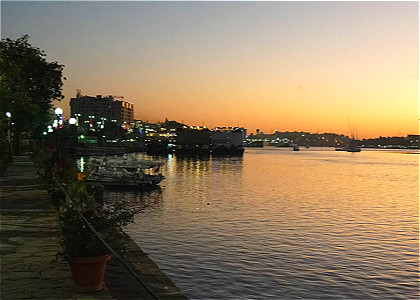Facts about Aswan for Every First-Time Traveler to Know
Aswan is one of the three tourist cities on the Nile, the other two being Luxor and Cairo. Aswan was the ancient link to the rest of Africa. It was also the military base against the Nubia. Earlier the city was called “Swenett”, named after the Greek goddess Eileithyia. This was the southernmost Egyptian town and treated as a strategic military base by all. There are many interesting facts about Aswan. Let us go through them to understand this location better.Basic Facts about Aswan

Aswan City
|
• The tombs in Aswan reveal facts about the old and middle kingdom of the ancient era.
• Aswan was a source of granite and most of the Egyptian shrines and monuments are made of stones procured from there. This includes the pyramids of Giza.
• A busy market in Aswan is located on the east bank of the Nile River near the first cataract.
• Now Aswan has expanded and included the Island of Elephantine.
• Aswan is a part of the UNESCO creative city network in the craft and folk-art category. See also Egyptian Art
• The population of Aswan is 1,568,000.
• The city was formally spelt as Assuan or Assouan. The name was derived from the Egyptian and Arabic language (See Language in Egypt). It was later Romanized to Aswan.
• Aswan is located in the Upper Egypt 220km (137mi) in the south of Luxor and 890km (553mi) south of Cairo. It is positioned on the foothills of the Nile Valley.
• The original habitants of Aswan are the Nubians (30%), they speak the Nubian language, the rest are Arabs after the Islamic invasion and they speak Arabian.
• Gold and ivory were sold in Aswan in ancient times. Known as ‘Sonu’, it was the commercial center where the Nubia convoys were received.
• Aswan always held an important position in ancient times. Today, too, owing to the construction of the Dam, it holds its place of importance.
• Aswan enjoys a dry climate throughout the year. The weather remains warm and pleasant all year through. In the summers, May-September the temperature is quite high and shoots up to 40°C (104 ?). In the winter’s temperature falls to 23°C (73.4 ?)
Facts about Aswan Temple Restoration
• The development of the Aswan dam led to flooding and destruction of many ancient temples in Aswan.
• The Abu Simbel and the Philae Temple are masterpieces of restoration conducted under the UNESCO in the 60s.
|
|
|
• The temples were saved and transported to higher locations without compromising the monumental structures and their placement. This extraordinary feat was successfully achieved, and visitors are not just amazed at the temple architecture but wonder how the transfer was made with such details and intricacies intact.
• The city also has an ancient connection of spirituality as they worshipped Khnum and Isis, the deity who kept the Nile River abundant.
• The Abu Simbel temple built under Ramses II in 1244B.C. is landmark evidence of his victory in the battle of Kadesh. The temple is dedicated to four Gods Amon-Re, Ptah, Hathor and Ra-Horakhte.
• The Solar Festival (See also Egypt Festivals) on 22nd October and February attract people to the temples of Abu Simbel and Philae which is another monumental wonder not just for its architecture but also for its restoration. The temple is devoted to Isis in 690BC.
• The Unfinished Obelisk is also in Aswan and attracts tourists offering insight into the method of architecture used in ancient Egypt.
• The temple deity Sobek, the protector of Nile is worshipped here. Temple of Edfu is dedicated to the Sky God Horus. The temple stands at the place where Horus and his evil
Uncle Set participated in a battle.
• There are many hidden and unknown sights in Aswan like the Monastery of St. Simeon, Tombs of the Nobles, the Aga Khan Mausoleum, to name a few.
Facts about Aswan High Dam
• The Aswan Dam is built on the Nile River, the longest river in the world. The Aswan dam measures 11,811 ft in length and 364 ft. in height, and the base measures 3,215 ft.

Aswan High Dam
|
• The Dam took 10 years to build and was fully completed in 1970.
• When the dam was constructed more than 90,000 Nubians were evacuated from the area and relocated as far as 45 km (28 mi) from where they formally resided allowing larger space for the dam.
• The Aswan dam supplies more than half of the total electricity to Egypt. The dam generates roughly 10 billion kW of electricity per hour. It is among the most expensive constructions in the world.
• The construction of the dam has helped the nearby areas with irrigation and also hydroelectricity. Flooding used to cause major damage, but the rich nutrients deposited in the flooded areas enriched the soil which does not happen anymore.
• The dam was planned by British architects but engineered by the Soviet Union.
• During the construction of the Dam, ancient temples like Abi Simbel and Philae Temple had to be moved bodily as they were being lost due to the floods.
• The beautiful reservoir of Lake Nasser is constructed on the Aswan Dam. Located near the old Aswan Dam, there is an island named Agilkia Island only 3 minutes from the coast by boat.Geographical Facts about Aswan
• It is believed by geographers that the Tropic of Cancer runs directly over Aswan and the sun passes directly overhead during the summer solstice (June 21st). But in reality, there is at ½ degree difference and Aswan falls in the north of the Tropic of Cancer.
• Eratosthenes, assuming this to be true, measured the shadow length of the solstice in Alexandra and made the first known calculation of the circumference of the Earth.Religious Facts about Aswan
• When Ptolemies began ruling over Egypt in the 4th century BC. they restored the PhilaeTemple and practiced the worship of Osiris and Isis to please the local Egyptians. This was later followed by the Romans who continued with the same religious practice.
• Trajan the Roman Emperor built a smaller temple inside the Philae Temple dedicated to Isis.
• With the advent of Christianity in Egypt, the converts were treated with hostility by theRomans. In fact, some of the Copt sects were even killed. But despite the intolerance, some ancient Egyptian pharaonic temples were converted to churches. The Philae Temple Island also gained fame as Bishopric and Christianity slowly imbued into Egypt till it touched Nubia.
• With the advent of Islam in the 10th century in Aswan, trading caravans first passed through Aswan before reaching Aydhab port in the shore of the Red Sea (See also Things to Do in the Red Sea), even before it reached Yemen, Hajaz or India.Present Facts about Aswan
• Tourists swim despite the water depth and currents in the Nile River in Aswan, as some areas are suitable for swimming. Sailing is also a favorite practice here.
• The local attraction (See also Top Aswan Attractions) apart from the temples include the island and museum, Abu Simbel and the Philae Temple.

